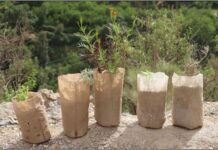By: Álvaro Arellano Silva (Baba Zuwa) WIPO GREEN Listed Technology –PCT/IB2025/XXXXXX
After years working on oil drilling rigs in Alberta, Canada, I made the unlikely transition from petroleum to plants — and from extraction to regeneration. My name is Álvaro Arellano Silva, also known as Baba Zuwa, and I’m the inventor of a new vertical hydroponic grow system designed to address one of the greatest global challenges: how to grow food in a world where water is scarce, land is degraded, and climate stress is rising.
In my earlier years, I witnessed firsthand the environmental impact of extractive industries. Conversations with Elders in Canada’s north often echoed the same theme — that as development grew, nature shrank. I eventually left the oil field and moved to Africa, where I founded a biodiesel program in Zimbabwe called Oil Castor Zimbabwe. Our goal was to cultivate castor beans for sustainable fuel production. The initiative was recognized and gazetted by the Zimbabwean government, offering a local solution to an international crisis.
But it was on those farms — watching farmers struggle with pests, spraying chemicals across wide, open fields — that I began to imagine a different kind of agriculture. One where crops weren’t vulnerable on the ground. One where soil wasn’t required. One where water loss could be minimized.
In 2019, a life-altering accident resulted in an above-knee amputation. The physical setback forced me to slow down — and it gave me the clarity to refine the idea I had been sketching for years. Using salvaged potato sacks and wicking material, I built my first vertical grow panel. It was crude, but it worked. It kept crops off the ground, used far less water, and created a cleaner, safer growing environment. From there, I spent years refining the system, culminating in what is now published on WIPO GREEN.
The Baba Zuwa system is a modular, fabric-based vertical grow panel that can support up to 32 plants per panel, mounted to walls, fences, balconies, or poles. It uses a layered fabric structure with gravity-fed irrigation and a closed-loop recirculation system. No soil is required. Water use is reduced by up to 90%. It requires no electricity, and it’s ideal for drought zones, refugee camps, off-grid settlements, and urban rooftops.
Early testing has shown it to be particularly effective for leafy greens, herbs, and medicinal plants, especially in areas where land or water is limited. Farmers no longer need to trench, spray, or worry about soil-borne pests. The design also opens the door for fashion-integrated agriculture, where panels can be customized with local art, cultural motifs, or branding.
The vision is bold, but simple: to help people grow food anywhere. To empower families, schools, NGOs, and cities to produce what they eat — even in the harshest conditions.
Today, I live in Chile and continue building the Baba Zuwa brand globally. I’ve filed for international patent protection, created working prototypes, and printed branded panels. My website showcases the system and links to social media channels where people can see the panels in action. A Kickstarter campaign is in development to make the first large batch accessible to farmers, educators, and aid groups worldwide.
For remote villages, for rooftops in megacities, for UN feeding programs — the potential is vast. What began as a small prototype stitched by hand in Zimbabwe may now grow into a solution for feeding millions, one wall at a time.









